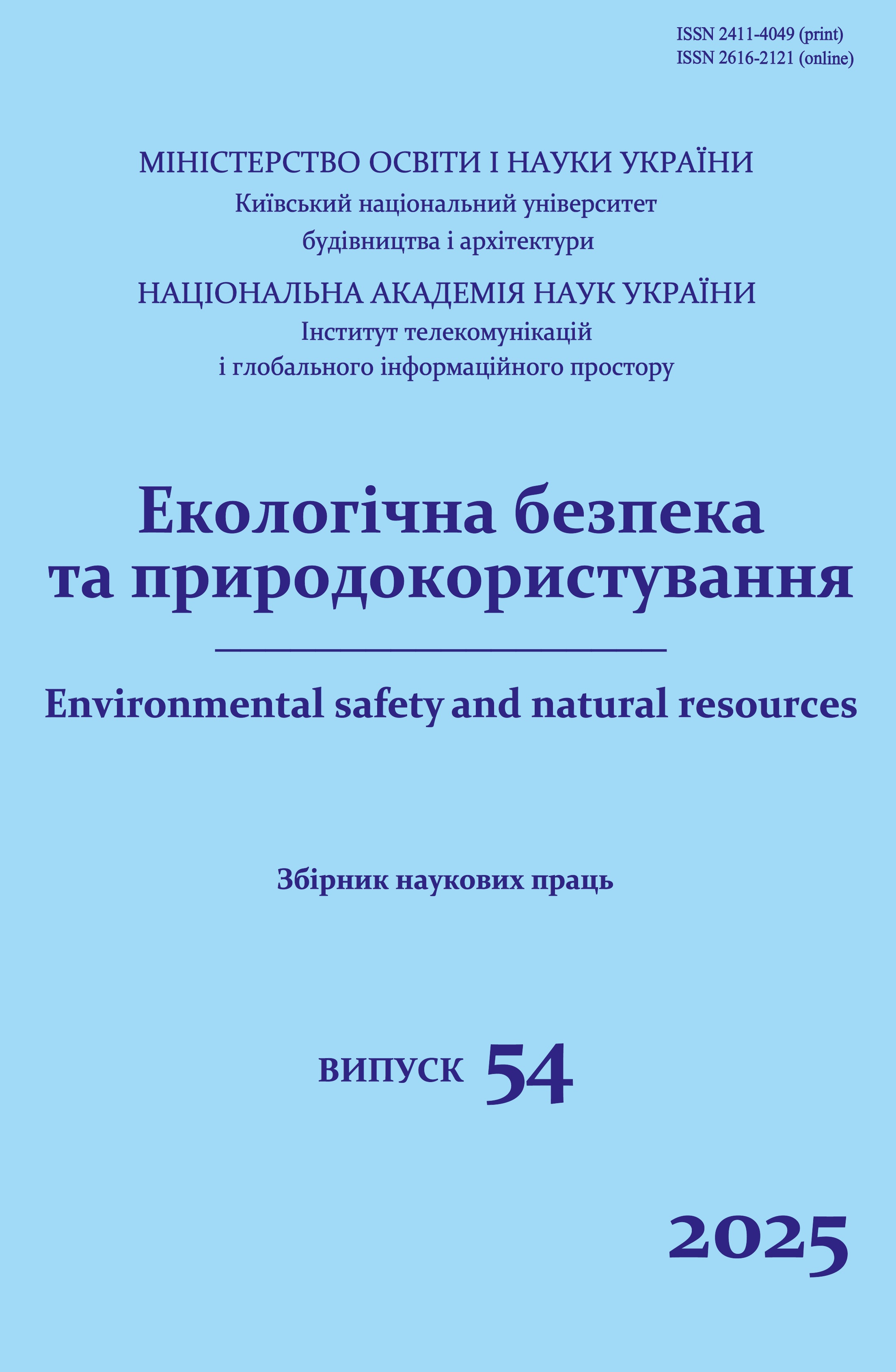Improvement of explosion hazard monitoring systems for technogenic facilities
DOI:
https://doi.org/10.32347/2411-4049.2025.2.62-73Keywords:
hazard, combustible gases, fuel, monitoring systems, sensors, integrated explosion hazard assessmentAbstract
The purpose of this work is to find solutions aimed at improving the explosion hazard monitoring systems of man-made facilities in the presence of a multicomponent fuel-air mixture by means of an integrated explosion hazard assessment and improving the accuracy of control equipment.
Materials and methods. Analytical methods for studying the process of oxidation of combustible gases and vapors on catalysts based on the classical provisions of electrical engineering, thermodynamics and catalysis, experimental studies of serial single-chamber thermocatalytic sensors of pellet type with a platinum-palladium catalyst when they operate in a multicomponent fuel-air mixture, evaluation and generalization of the results of theoretical and experimental studies were used in this work.
Results. The peculiarities of the oxidation process of combustible gases and vapors in thermocatalytic sensors with a non-selective platinum-palladium catalyst under changing the temperature regime of the working thermocouple were established. It has been shown that thermocatalytic sensors with a non-selective platinum-palladium catalyst under a certain temperature regime of operation allow for an unambiguous assessment of the explosiveness of such components as methane, butane, and heptane, which allows for an integrated assessment of the explosiveness of a multicomponent fuel-air mixture. For the studied sensors, this is ensured by selecting a preheating temperature of 350 °C for the working thermocouple in the air.
Scientific novelty. The conditions under which thermocatalytic sensors with a non-selective platinum-palladium catalyst allow for an integrated unambiguous assessment of the explosive hazard of the environment, including in the presence of a multicomponent fuel-air mixture, have been established.
Practical significance. It consists in establishing the conditions under which it is possible to unambiguously assess the explosive properties of fuel-air mixtures, including multicomponent ones, using a single thermocatalytic sensor, which reduces the cost of explosion monitoring systems and increases the reliability of explosion control under conditions where various explosive gases and vapors of volatile combustibles can simultaneously accumulate in the air.
References
Stoetskyi, V.F., Dranyshnikov, L.V., Esypenko, A.D., Zhartovsky, V.M., Naivert, O.V. (2006). Man-made safety management of high-risk facilities: monograph. Kyiv, Ukraina: Aston. 410 [In Ukrainian].
Holinko, O., Yuldasheva, N., Zhartay, Z., Mirzoieva, T., Petrychenko, O., Hulevets, V. (2023). Methodology of creation and development of information systems for technological safety of mining facilities. Naukovyi Visnyk Natsionalnoho Hirnychoho Universytetu, №6, 127-133. https://doi.org/10.33271/nvngu/2023-6/127 [In Ukrainian].
Golinko, V., Golinko, O. (2023). Theoretical and methodological principles of computer monitoring of explosion protection systems. Naukovi pratsi DonNTU. Seriya: «Informatyka, kibernetyka ta obchyslyuvalʹna tekhnika», №2-37, 34-41. Retrieved from https://iktv.donntu.edu.ua/№2-372023/ [In Ukrainian].
Golinko, V., Kotlyarov, A. (2010). Control of explosive environment in mining and equipment of coal mines. Monograph. Dnipropetrovsk Ukraina: "Lyra" publishing house, 368 s. ISBN 978-966-383-269-2 [In Ukrainian].
Golinko, V.I., Belonozhko, A.V., Belonozhko, V.V. (2014). Control of the explosion hazard of gas mixtures during emergency gas contamination of mine workings: monograph. Natsional'nyy gornyy universitet. Dnepropetrovsk: NGU, 209 [In Ukrainian].
Rachid Laref, Diaa Ahmadou, Etienne Losson, Maryam Siadat (2017). Orthogonal Signal Correction to Improve Stability Regression Model in Gas Sensor Systems. Journal of Sensors, Volume 2017. Retrieved from https://www.hindawi.com/journals/js/2017/9851406/
Yuri Koval (2012). New semiconductor MEMS gas sensors from FIGARO ENGINEERING. CHIP NEWS Ukraine, 3(113), 52-55. Retrieved from https://storage.sea.com.ua/files/links/mems-datciki-gaza-figarocnno320121504002845.pdf
Vovna, A., Zori, A. (2013). High-speed meter of methane concentration in the mine atmosphere of coal mines. Visn. Kremenchutsk. nat. un-tu im. Mikhail Ostrogradsky, 6 (83), 114–119. Retrieved from https://visnikkrnu.kdu.edu.ua/statti/2013-6(83)/114.pdf [In Ukrainian].
Vovna, O., Zori, А., Akhmedov, R. (2017). Increasing the accuracy of the optoelectronic methane concentration meter of coal mines. Visnyk Natsionalʹnoho tekhnichnoho universytetu «KHPI». Zbirnyk naukovykh pratsʹ. «Elektroenerhetyka ta peretvoryuvalʹna tekhnika», 4 (1226), 19–24. Retrieved from https://repository.kpi.kharkov.ua/server/api/core/bitstreams/b14d9ec7-0fc8-4ff9-974d-26da69298c11/content [In Ukrainian].
Vovna, O.V., Zori, А.А., Khlamov, M.G. (2010). Method of compensating for dynamic error of infrared methane concentration meter for coal mines. Visnyk Natsionalʹnoho tekhnichnoho universytetu «KHPI». Zbirnyk naukovykh pratsʹ. «Elektroenerhetyka ta peretvoryuvalʹna tekhnika», 2, 65–70. Kharkiv. NTU "KhPI". Retrieved from https://core.ac.uk/download/pdf/162886053.pdf [In Ukrainian].
Ishchenko, V.A., Petruk, V.G. (2010). Highly sensitive means of controlling small concentrations of gases: monograph. Vinnytsia: VNTU. 138 s. Retrieved from http://ir.lib.vntu.edu.ua [in Ukrainian].
Gas detector “VARTA 1-03.24”. Retrieved from https://temio.com.ua/product-category/varta-1-promyslovi/
Downloads
Published
How to Cite
Issue
Section
License
Copyright (c) 2025 Vasyl Holinko, Oleg Kuznetsov, Oleksandr Holinko

This work is licensed under a Creative Commons Attribution 4.0 International License.
The journal «Environmental safety and natural resources» works under Creative Commons Attribution 4.0 International (CC BY 4.0).
The licensing policy is compatible with the overwhelming majority of open access and archiving policies.

